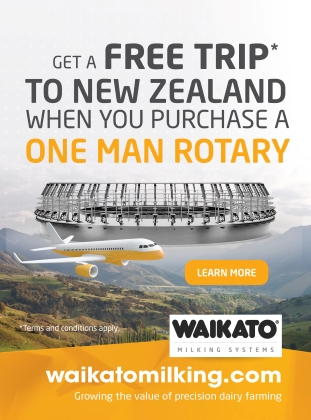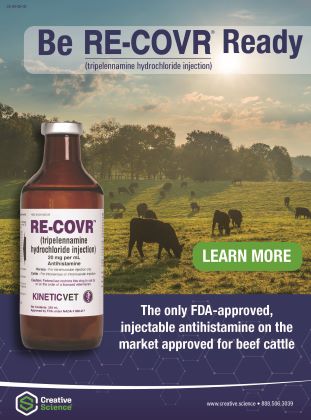Calving Pens: Helping the Calving Process Be Safe, Secure & Efficient

Calving Pens: Helping the Calving Process Be Safe, Secure & Efficient
By Maura Keller
Calving pens have changed significantly in recent years – evolving from the traditional manual headgate attached to two posts with adjacent panels. Today, calving pen designs are focused on the safety and well-being of the rancher, cow and calf.
From semi-circular designs to portable rectangular-shaped units to oversized square pens, today’s calving pens provide dairy producers with a variety of options.
One of the leading manufacturers of calving pens is Arrowquip, has created a quarter-circle design calving pen. This unique shape helps move cattle easily with a sweepgate into a self-catch head gate. At its core, Arrowquip’s calving pen design allow the dairy product to have solid control without having to actually get into the pen with the animal, further ensuring the safety of the dairy farmer.
The company’s dual-purpose calving pen is built for safety, control, and accessibility during the calving process and other critical situations that dairy farmers and their animals may face. The built-in sweep gate and circular pen design, help get vulnerable animals into the head gate quickly, safely and with minimal effort.
New bushings and upgraded hinges have been added Arrowquip’s wide 7.9’ back gate on the calving pen, improving access for pulling calves. And when not in use for calving, the calving pen can provide alternative uses, including isolating sick animals and providing access to safely perform treatments and procedures. In fact, Arrowquip’s calving pen is designed with dual functionality in mind, which means the calving pen can be used as a basic chute to accommodate any type of cattle or dairy cows that require isolation from the herd.
And because safety is paramount, Arrowquip has designed their calving pen to include straight sides on the self-catch head gate in order to keep animals calm, reduce stress points, and eliminate a choking risk if they go down. What’s more, the dairy producer is kept safe even if the animal pushes back on the gate, thanks in part to sweep gate stops on the curved panels. reduce stress points, helping keep cattle calm and eliminating a choking risk if they go down.
Winkel Manufacturing in Glen Elder, KS has also spent time developing a solid calving chute and pen that allows producers to use the equipment for more than just calving. The company’s calving pen boasts 12-foot swing-out gates on both sides of the calving chute, which offers the producer exceptional access to the animal during the calving process, as well as for vaccinations, artificial insemination, and pregnancy checks. The calving pen’s 12-foot-long rubber flooring also ensure solid footing for the cow and producer alike.
The company’s calving pen also boasts hooks and latches to make 12’x10’ pens on each side of the calving chute and removable vertical bars are ideal for milking and assisting the animal during the calving process.
Although managing dairy cows and calving has become a science, with clearly identified timelines, sometimes a calving pen may be required to be transported to an animal’s location. Winkel’s calving pen on wheels is ideal for situations in which the pen need to be transported to different areas. This portable/mobile calving pen is elevated into position for transport by a cable winch and can be lowered and raised quickly and efficiently. It also features a detachable wheel kit that including 15” tires on six-bolt wheels. And the self-catching head gate provides a safe means for both animal and producer alike.
Simple, yet secure calving pen designs is what many dairy producers are looking for. That’s why Apache Equipment’s Palco calving pen features easy access from all sides, as well as a parallel bar stanchion to prevent choking. Nursing doors on both sides of the cow streamlines the process, while the use of drop pins allows producers to put the pen together or tear it down in a matter of minutes.
Calving Pen Specifics
The array of calving pens available means that dairy producers need to determine the best option for their needs. Choosing a calving pen involves considering factors such as size, material, cost, ease of use, ease of cleaning, portability, and durability. It is also important to select a calving pen that will reduce calving pen stress and provide a safe experience for the producer, cow and calf – as the calving pen is often one of the most dangerous places on a ranch or farm.
In addition to security components, such as latches and locking mechanisms, Arrowquip recommends that producers evaluate the type of access needed, depending on whether the calving pen is inside or outside. Most importantly, for safety and security and proper restraint of the animal, Arrowquip recommends a head gate or other restraint.
Self-catching headgates, for example, are considered ideal for producers working alone. Look for headgates that include adjustable side panels to accommodate different animal sizes and include a guard over the release catch.
Proper placement of the calving pen is dependent on each producer’s situation, but it is vital that the calving pen is placed close to a water source, as the dairy cow will need extra drinking water while calving.
Arrowquip also advises that the calving pen is thoroughly disinfected after each use, with fresh, clean bedding and features adequate ventilation. This helps offset any potential bacteria or diseases that may affect the calf’s health and well-being. In addition, the cleanliness of the calving pen is vital for the uterine health of the cow, as uterine infections can emerge in a calving pen that has not adequately sanitized between calvings.
Clay, sand and concrete are the recommended bases for calving pens. However, be aware that wet concrete can be slippery and provide little traction for the cows. Remember, if an animal doesn’t feel secure in their footing, it may affect the entire calving process. Grooved concreate, rubber mats, and sand – all covered with thick layers of straw or sawdust will help the calving pen work to its full potential. Some calving pens provide a permanent mess floor for even more stability during the birthing process.
Finally, any chosen calving pen needs to work with the existing infrastructure of a farm or ranch, so that it’s use is streamlined, efficient and safe.




